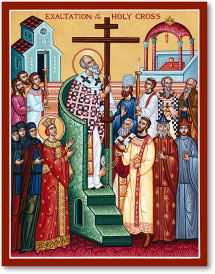THE HOLY CROSS OF CHRIST has much history and lore behind it, and today on the feast of the Holy Cross it is a good time to consider this...
"The stone which the builders rejected"
Archeological excavations begun in 1960 revealed that the Mount of Golgotha were part of an ancient quarry, in use as early as the 7th century B.C. Within the quarry, the Rock of Golgotha was a section of rocky ground that was not used, probably because of the mediocre durability and quality of the chalky rock, thus fulfilling the Psalmist's prophetic words: "The stone the builders rejected has become the chief cornerstone" (Psalm 118:22).
Beneath the cross, the most ancient chapel
In 1977 a double-cave tomb was discovered only three meters directly below the present shrine of the Crucifixion. The cave had been turned into a place of worship by Christ's followers, possibly even his disciples, which showed evidence of being plastered and decorated in the first century. This is the most ancient chapel in Christian history.
An pagan emperor marks the spot
Seeing the ruins of Jerusalem wrought by the Roman armies in the year 70 A.D., the Roman Emperor ordered the gardens and cemeteries around Golgotha, and Christ's Holy Tomb itself, to be filled in with dirt, and a great platform erected over the spot, which later was the site of a temple to the goddess Venus – thus ironically safeguarding the memory of the site of Christ's death and burial. Ancient histories testify that the Rock of Golgotha actually protruded through the pagan platform, visible to all. Saint Jerome writes that on the peak of Golgotha was a pedestal with a stone statue of Aphrodite. This made it very easy for St. Helen's excavators to find the tomb of Jesus on their first attempt.
Three crosses are found
Commissioned and funded by her son Saint Constantine, the emperor of Byzantium, Saint Helen embarked on a mission to the Holy Land in 326 to restore the Christian holy places and recover the important relics of Christianity. At the time of Saint Helen's excavations around the site of Golgotha, three crosses were found in a rock cistern, along with the titlulus (the wood plaque inscribed with Jesus Nazaranus Rex Iudaeorum). This cistern can be visited today, in the deepest levels of the Church of the Holy Sepulchre in Jerusalem off of the Armenian chapel. It is a cavernous excavation holding a large quantity of water, a minor miracle of ancient laborers.
Which is the Lord's?
The three crosses and the titulus were removed from the cistern. A woman dying from a terminal disease was brought to the spot. She touched the crosses, one by one. After she touched the third cross, she was immediately cured, thereby identifying the true Cross.
Lost again, found again
 In 614 King Chosroes of Persia invaded the Holy Land, destroying all Christian churches except the Church of the Nativity, which was spared because of the frescoes of the three Magi on its walls (the invaders recognized people of their own land in these images). When he captured Jerusalem he took the Holy Cross as trophy back to his homeland. Thirteen years later the Byzantine Emperor Heraclius defeated Chosroes and regained the relic, taking it first to Constantinople and then back to Jerusalem.
In 614 King Chosroes of Persia invaded the Holy Land, destroying all Christian churches except the Church of the Nativity, which was spared because of the frescoes of the three Magi on its walls (the invaders recognized people of their own land in these images). When he captured Jerusalem he took the Holy Cross as trophy back to his homeland. Thirteen years later the Byzantine Emperor Heraclius defeated Chosroes and regained the relic, taking it first to Constantinople and then back to Jerusalem.
A shipload of relics of the Cross?
By the end of the Middle Ages so many churches claimed to possess a piece of the True Cross, that the famous Protestant John Calvin mockingly remarked that there was enough wood in them to fill a ship.
Or was there? The 19th century architect and scholar Charles Rohault de Fleury decided to see for himself, and tracked down and measured every surviving relic of the True Cross. Estimating the weight and size of the Cross, calculating the volume of wood, he then calculated the total mass of all the relics he inventoried,
plus a generous allowance for fragments that were in private hands or otherwise hadn't come to his attention. He then multiplied this number by ten, and found that even with this generous multiplication the volume of the relics didn't account for even a fifth of the cross upon which Christ was crucified.
Where are they now?
Relics of the True Cross can be found in Catholic and Orthodox Christian churches throughout the world today, including a large relic which is on display for veneration in the Church of the Holy Sepulchre in Jerusalem.